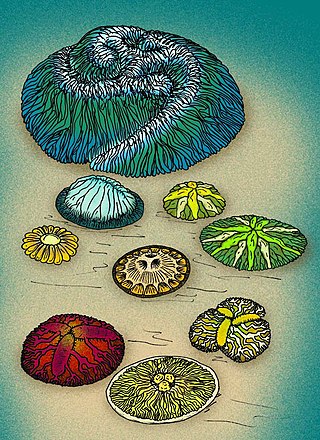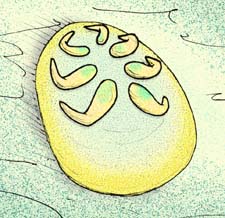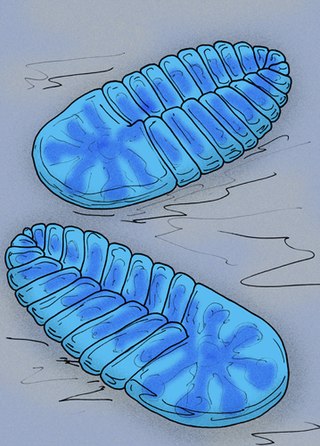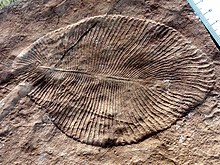
Dickinsonia is a genus of extinct organism, most likely an animal, that lived during the late Ediacaran period in what is now Australia, China, Russia and Ukraine. It is one of the best known members of the Ediacaran biota. The individual Dickinsonia typically resembles a bilaterally symmetrical ribbed oval. Its affinities are presently unknown; its mode of growth has been considered consistent with a stem-group bilaterian affinity, though various other affinities have been proposed. The discovery of cholesterol molecules in fossils of Dickinsonia lends support to the idea that Dickinsonia was an animal, though these results have been questioned.

Kimberella is an extinct genus of bilaterian known only from rocks of the Ediacaran period. The slug-like organism fed by scratching the microbial surface on which it dwelt in a manner similar to the gastropods, although its affinity with this group is contentious.

Tribrachidium heraldicum is a tri-radially symmetric fossil animal that lived in the late Ediacaran (Vendian) seas. In life, it was hemispherical in form. T. heraldicum is the best known member of the extinct group Trilobozoa.

Yorgia waggoneri is a discoid Ediacaran organism. It has a low, segmented body consisting of a short wide "head", no appendages, and a long body region, reaching a maximum length of 25 cm (9.8 in). It is classified within the extinct animal phylum Proarticulata.

Cephalonega stepanovi is a fossil organism from Ediacaran deposits of the Arkhangelsk Region, Russia. It was described by Mikhail A. Fedonkin in 1976

Vendia is a genus of oval-shaped, Ediacaran fossils ranging from 4.5 to 12.5 mm long. The body is completely segmented into isomers, which are arranged alternately in two rows longitudinal to the axis of the body. The larger isomers cover the smaller ones externally but the posterior ends of all the isomers remain free. The transverse elements decrease in size from anterior to posterior and are all inclined in the same direction.

Trilobozoa is a phylum of extinct, sessile animals that were originally classified into the Cnidaria. The basic body plan of trilobozoans is often a tri-radial or radial sphere-shaped form with lobes radiating from its centre. Fossils of trilobozoans are restricted to marine strata of the Late Ediacaran period.

Praecambridium sigillum is an extinct organism that superficially resembles a segmented trilobite-like arthropod. It was originally described as being a trilobite-like arthropod, though the majority of experts now place it within the Proarticulata as a close relative of the much larger Yorgia. It is from the Late Ediacaran deposit of Ediacara Hills, Australia, about 555 million years ago. On average, P. sigillum had at least 5 pairs of segments, with each unit becoming progressively larger as they approach the cephalon-like head.

Ovatoscutum concentricum is one of many enigmatic organisms known from the Ediacaran deposits of the Flinders Ranges, Australia, and the White Sea area in Russia, dating around 555 Ma.

Vendiamorpha is a class of extinct animals within the Ediacaran phylum Proarticulata.

Tamga hamulifera is a disk-shaped fossil from Precambrian strata of the White Sea area, in Russia, the only member of the genus Tamga.

Isomer is an element of transverse body articulation of the bilateral fossil animals of the Phylum Proarticulata from the Ediacaran (Vendian) period. This term has been proposed by Andrey Yu. Ivantsov, a Russian paleontologist from the Laboratory of the Precambrian organisms, Paleontological Institute, Russian Academy of Sciences.

Epibaion is a trace fossil imprint of the Ediacaran animals of the phylum Proarticulata, which became extinct in the Precambrian. Imprints often occurring in chains, that is interpreted as a feeding trace; some chains terminate in a body fossil, allowing their maker to be identified. Several specimens are known; E. waggoneris was produced by Yorgia waggoneri; E. costatus by Dickinsonia costata, and E. axiferus, the type species, has as yet not been found with a trace-maker. It is proposed that the Australian fossil Phyllozoon is also a feeding trace of Proarticulata.

Andiva ivantsovi is a Vendian fossil, identified to be a bilaterian triploblastic animal in the Ediacaran phylum Proarticulata, known from the Winter Coast, White Sea, Russia. It was first discovered in 1977, and described as a new species in a new genus by Mikhail Fedonkin in 2002. It lived about 555 million years ago. Fossils of Andiva also occur in South Australia. All known fossils of Andiva are external molds.

Lossinia lissetskii is a fossil marine organism from Precambrian strata of the White Sea area, in Russia. L. lissetskii is a member of the extinct phylum Proarticulata.

Cyanorus singularis is a small proarticulatan, closely related to Spriggina and Marywadea. Its two largest pairs of appendages are located on the anterior part of the body. The anterior part of the body was most likely not segmented. The axial structure of it combines features of the Vendia species and Dickinsonia species. It was found in the Upper Vendian of the White Sea area, Arkhangel'sk Region. It is a White Sea Ediacaran fossil and it became extinct during the Late Precambrian.

Archaeaspinus fedonkini is an extinct proarticulatan organism from the Late Precambrian (Ediacaran) period.

Cephalozoa are an extinct class of primitive segmented marine organisms within the Phylum Proarticulata from the Ediacaran period. They possessed bilateral symmetry and were characterized by a thin, rounded body.

Ivovicia is an extinct genus of proarticulates. This monotypic genus has only one species: Ivovicia rugulosa.The genus is named after the Ivovik creek, near the place where the specimen was found.


























